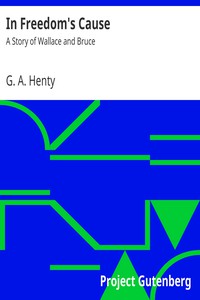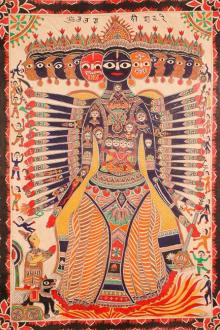In Freedom's Cause : A Story of Wallace and Bruce, G. A. Henty [chromebook ebook reader txt] 📗

- Author: G. A. Henty
Book online «In Freedom's Cause : A Story of Wallace and Bruce, G. A. Henty [chromebook ebook reader txt] 📗». Author G. A. Henty
"It looks impossible," Randolph said, gazing at the precipice; "but as you tell me that you have done it others can do the same. I will myself follow your guidance."
"And I," Archie said.
"What, Sir Archie, think you is the smallest number of men with whom, having once gained footing on the wall, we may fight our way to the gates and let in our friends."
"I should think," Archie replied, "that with thirty men we might manage to do so. The confusion in the garrison will be extreme at so unexpected a surprise, and if we divide in two parties and press forward by different ways they will think rather of holding together and defending themselves than of checking our course, and one or other of the parties should surely be able to make its way to the gates."
"Thirty let it be then," Randolph said. "Do you choose fifteen active and vigilant men from among your retainers; I will pick as many from mine, and as there is no use in delaying let us carry out the enterprise this very night; of course the rest of our men must gather near the gates in readiness to rush in when we throw them open."
As soon as it was dark the little party of adventurers set out on their way. Francus acted as guide, and under his leading they climbed with vast difficulty and no little danger up the face of the precipice until they reached a comparatively easy spot, where they sat down to recover their breath before they prepared for the final effort.
They could hear the sentries above speaking to each other, and they held their breath when one of them, exclaiming suddenly, "I can see you!" threw down a stone from the battlement, which leapt, crashing down the face of the rock close beside them. Great was their relief when a loud laugh from above told them that the sentry had been in jest, and had but tried to startle his comrade; then the two sentries, conversing as they went, moved away to another part of the walls.
The ascent was now continued, and proved even more difficult than that which they had passed. They were forced continually to halt, while those in front helped those following them, or were themselves hoisted up by the men behind. At last, panting and breathless, they stood on the summit of the rock, on a narrow ledge, with the castle wall rising in front of them. They had, with enormous difficulty, brought up a light ladder with them. This was placed against the wall. Francus was the first to mount, and was followed by Sir Andrew Grey, whom Randolph had invited to be of the party, by Archie Forbes, and by the earl. Just as the latter stepped on to the battlements the sentries caught sight of them and shouted:
"Treason! treason! to arms!" An instant stir was heard in the castle. Rapidly the thirty men followed each other up the ladder, and so soon as the last had gained the battlements they divided in three bodies, each headed by one of the leaders. One party descended straight into the castle and there attacked the soldiers who were hurrying to arms, while the others ran along the wall in opposite directions, cutting down the sentries and brushing aside all opposition until together they met at the gate. This was thrown open, and the Scots outside running up at the top of their speed poured into the castle. At first Randolph's party, which had descended into the courtyard, had been hotly pressed, and had with difficulty defended themselves; but the attention of the startled garrison was distracted by the shouts upon the walls, which told that other parties of their assailants had gained footing there. All sorts of contradictory orders were issued. One commanded them to cut down the little party opposed to them, another ordered them to hurry to the walls, a third to seize the gate and see that it was not opened. The confusion reached its height as the Scots poured in through the open gate. The garrison, surprised and confounded as they were at this, to them, almost magical seizure of the castle by their foes, fought bravely until the governor and many of the officers were killed. Some of the men threw down their arms, and others, taking advantage of their knowledge of the castle, made their way to the gate and escaped into the open country.
The news of the capture was immediately sent to the king, by whose orders the castle and walls were razed to the ground, and thus another of the strongholds, by whose possession the English were enabled to domineer over the whole of the surrounding country, was destroyed.
While Douglas and Randolph were thus distinguishing themselves Edward Bruce captured the castle of Rutherglen, and afterwards the town of Dundee; and now, save Stirling Castle, scarcely a hold in all Scotland remained in English hands. Thus was Scotland almost cleared of the invader, not by the efforts of the people at large, but by a series of the most daring and hazardous adventures by the king himself and three or four of his knights, aided only by their personal retainers. For nine years they had continued their career unchecked, capturing castle by castle and town by town, defeating such small bodies of troops as took the field against them, England, under a supine and inactive king, giving itself up to private broils and quarrels, while Scotland was being torn piecemeal from her grasp.
After Edward Bruce had captured Dundee he laid siege to Stirling. As this castle had for many months resisted Edward I backed by the whole power of England, Bruce could make little impression upon it with the limited appliances at his disposal. From February till the 24th of June the investment continued, when the governor, Sir Philip Mowbray, becoming apprehensive that his provisions would not much longer hold out, induced Edward Bruce to agree to raise the siege on condition that if by the 24th of June next, 1314, the castle was not effectually relieved by an English force, it should then be surrendered.
No satisfactory explanation has ever been given of the reasons which induced Edward Bruce to agree to so one sided a bargain. He had already invested the place for four months, there was no possibility of an army being collected in England for its relief for many months to come, and long ere this could arrive the garrison would have been starved into surrender. By giving England a year to relieve the place he virtually challenged that country to put forth all its strength and held out an inducement to it to make that effort, which internal dissension had hitherto prevented. The only feasible explanation is that Edward Bruce was weary of being kept inactive so long a time before the walls of the fortress which he was unable to capture, and that he made the arrangement from sheer impatience and thoughtlessness and without consideration of the storm which he was bringing upon Scotland. Had it been otherwise he would surely have consulted the king before entering upon an agreement of such extreme importance.
Bruce, when he heard of this rash treaty, was highly displeased, but he nevertheless accepted the terms, and both parties began at once their preparations for the crowning struggle of the war. The English saw that now or never must they crush out the movement which, step by step, had wrested from them all the conquests which had been won with such vast effort under Edward I; while Bruce saw that a defeat would entail the loss of all that he had struggled for and won during so many years.
King Edward issued summonses to the whole of the barons of England and Wales to meet him at Berwick by the 11th of June with all their feudal following, while the sheriffs of the various counties and towns were called upon to supply 27,000 foot soldiers. The English of the settlements in Ireland were also summoned, besides O'Connor, Prince of Connaught, and twenty-five other native Irish chiefs, with their following, all of whom were to be under the command of Richard de Burgh, Earl of Ulster.
The Prince Bishop of Constance was requested to furnish a body of mounted crossbowmen. A royal fleet of twenty-three vessels was appointed to assemble for the purpose of operating on the east coast, while the seaports were commanded to fit out another fleet of thirty vessels. A third fleet was ordered to assemble in the west, which John of Lorne was appointed to command under the title of High Admiral of the Western Fleet of England. From Aquitaine and the French possessions the vassals were called upon to attend with their men-at-arms, and many knights from France, Gascony, and Germany took part in the enterprise.
Thus, at the appointed time over 100,000 men assembled at Berwick, of whom 40,000 were men-at-arms, and the rest archers and pikemen. For the great armament the most ample arrangements were made in the way of warlike stores, provisions, tents, and means of transport, together with the necessary workmen, artificers, and attendants.
This army surpassed both in numbers and equipments any that Edward I had ever led into Scotland, and is considered to have been the most numerous and best equipped that ever before or since has gathered on English ground. Of the whole of the great nobles of England only four were absent—the Earls of Warrenne, Lancaster, Arundel, and Warwick—who, however, sent their feudal arrays under the charge of relations.
Among the leaders of this great army were the Earls of Gloucester, Pembroke, Hereford, and Angus, Lord Clifford, Sir John Comyn, Sir Henry Beaumont, Sir John Seagrave, Sir Edmund Morley, Sir Ingram de Umfraville, Sir Marmaduke de Twenge, and Sir Giles de Argentine, one of the most famous of the Continental knights.
While this vast army had been preparing, Bruce had made every effort to meet the storm, and all who were loyal and who were able to carry weapons were summoned to meet at Torwood, near Stirling, previous to the 24th of June. Here Edward Bruce, Sir James Douglas, Randolph, Earl of Moray, Walter the Steward, Angus of Isla, Sir Archibald Forbes, and a few other knights and barons assembled with 30,000 fighting men, besides camp followers and servants. It was a small force indeed to meet the great army which was advancing against it, and in cavalry in particular it was extremely weak. The English army crossed the Border, and marched by Linlithgow and Falkirk toward the Torwood.
Each army had stirring memories to inspire it, for the English in their march crossed over the field of Falkirk, where sixteen years before they had crushed the stubborn squares of Wallace; while from the spot which Bruce selected as his battleground could be seen the Abbey Craig, overlooking the scene of the Scottish victory of Stirling Bridge. On the approach of the English the Scotch fell back from the Torwood to some high ground near Stirling now called the New Park. The lower ground, now rich agricultural land called the Carse, was then wholly swamp. Had it not been so, the position now taken up by Bruce would have laid the road to Stirling open to the English.
The Scotch army was divided into four divisions. The centre was commanded by Randolph. Edward Bruce commanded the second, which formed the right wing. Walter the Steward commanded the left wing, under the guidance of Douglas, while the king himself took command of the fourth division, which formed the reserve, and was stationed in rear of the centre in readiness to move to the assistance of either of the other divisions which might be hard pressed. The camp followers, with the baggage and provisions, were stationed behind the Gillies Hill.
The road by which the English would advance was the old Roman causeway running nearly north and south. The Bannock Burn was fordable from a spot near the Park Mill down to the village of Bannockburn. Above, the banks were too high and steep to be passed; while below, where ran the Bannock through the carse, the swamps prevented passage. The army was therefore drawn up, with its left resting on the sharp angle of the burn above the Park Mill, and extended where the villages of Easterton, Borestine, and Braehead now stand to the spot where the road crosses the river at the village of Bannockburn. In its front, between it and the river, were two bogs, known as Halberts Bog and Milton Bog, while, where unprotected by these bogs, the whole ground was studded with deep pits; in





Comments (0)